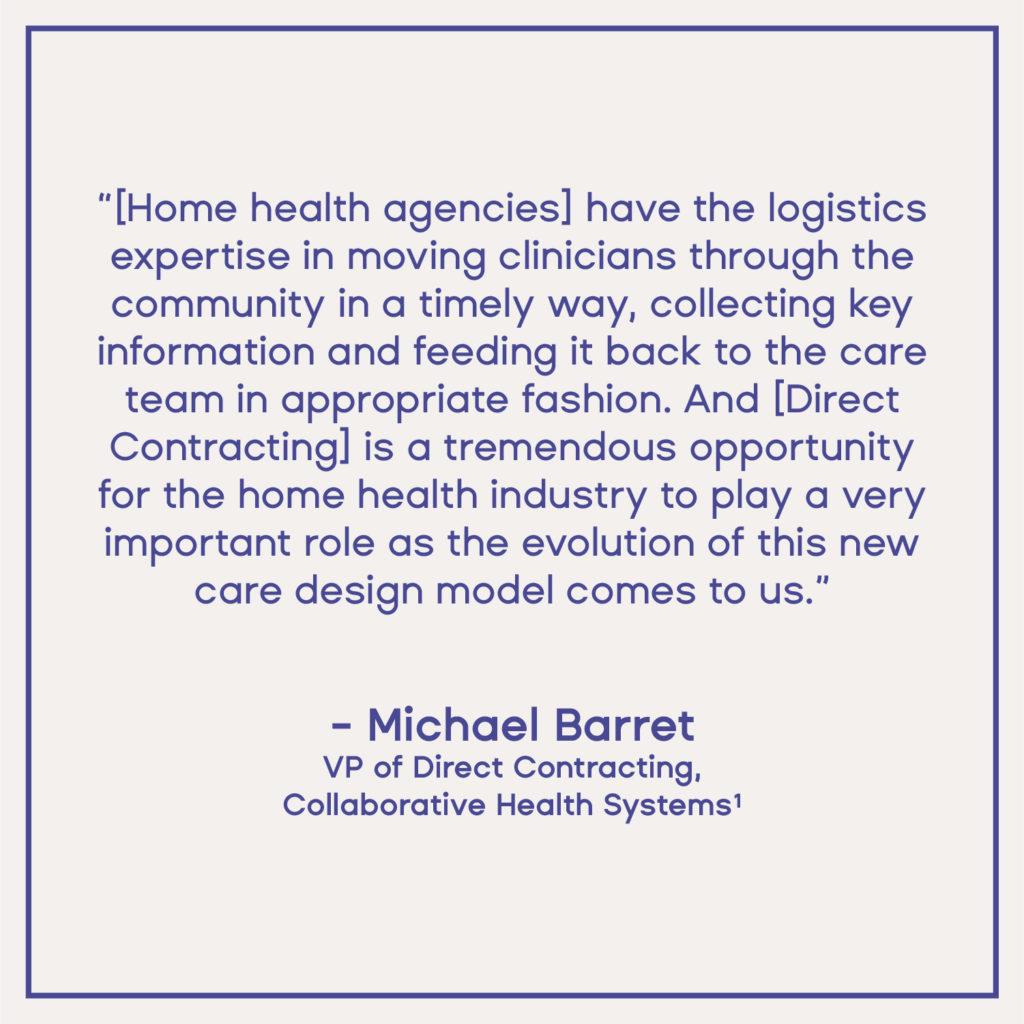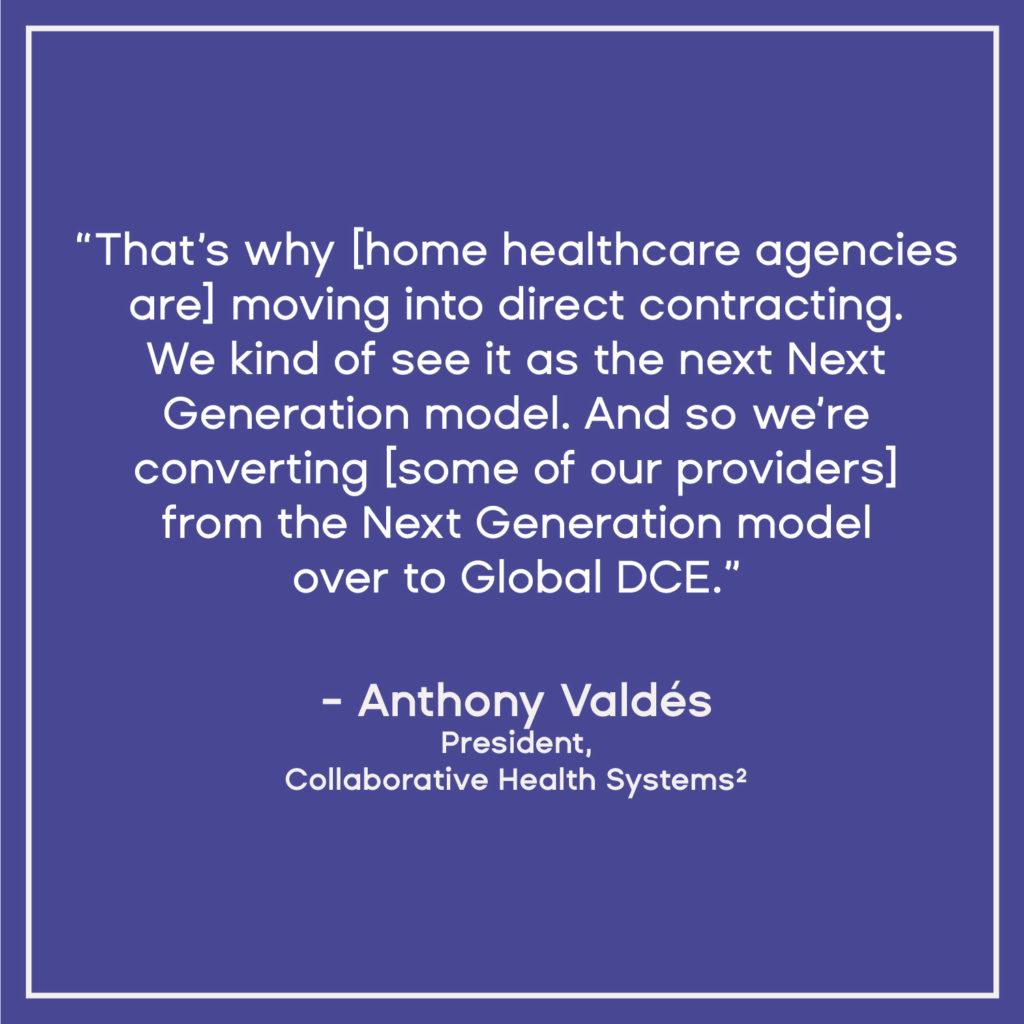The introduction of the Direct Contracting model by the Centers for Medicare and Medicaid Services (CMS) has attracted much attention. The model offers an opportunity for the healthcare system to take major steps away from a fee-for-service approach to healthcare services compensation. It also paves the way for higher-value healthcare by incentivizing providers to coordinate efforts toward better patient outcomes. To date, however, implementation of the direct contracting model has focused primarily on larger healthcare organizations and primary care providers. Yet opportunities for this model extend beyond this scope: especially to home-based healthcare entities.
Home-based healthcare organizations are in a unique position when it comes to value-based healthcare. Many have dealt with complex patient populations and thus understand the challenges associated with such care. In addition, they are also adept at team-based strategies and collaborative models in the pursuit of high quality care. These important capabilities increase the potential for success in the Direct Contracting model. This is why many healthcare experts believe home-based healthcare entities will play a major role in future value-based care pursuits.
Direct Contracting Model Options for Home-Based Healthcare
CMS’s Direct Contracting model essentially represents the latest approach toward higher-value healthcare. The model combines elements of accountable care organizations (ACO), Medicare Shared Savings Program (MSSP), and Medicare Advantage. The model allows Direct Contracting Entities (DCEs) and providers to take on risk as they pursue better patient outcomes. Participants can choose the global risk track–which means they are 100% at-risk to share in cost-savings or excessive expenditures–or they can select the professional risk track–where they share 50% risk, with the other 50% being retained by CMS. Home-based healthcare organizations can participate in these economics by becoming preferred providers to a given DCE.
The Direct Contracting model makes DCEs and the providers they work with more accountable for patient outcomes. They can also receive regular payments based on the number of patients for whom they are responsible. Using a capitated model, CMS pays participating DCEs 7% of the total cost of care for each patient in a combination of payments meant both to cover primary care services for attributed patients and to incentivize investment in population health tools and services. DCEs and their providers can make use of these predictable resources to create innovative programs that yield lower-cost, higher-value care. For home-based healthcare organizations, such an approach aligns well with their routine approach to patient care. This is why many such organizations are actively considering the direct contracting model moving forward.
Home Healthcare Agencies and the Direct Contracting Model
For home healthcare agencies, the direct contracting model has great appeal. These agencies are accustomed to effectively and efficiently managing a large staff of providers in the community. Their experience managing patients in the contexts that the program rewards (e.g. post-discharge visits to avoid unnecessary rehospitalization) means they will be able to contribute to high-value patient care in a home-based healthcare environment. But home healthcare agencies are also adept at collecting information from a variety of sources and sharing it broadly.
While these practices provide home healthcare agencies with pre-existing advantages, they also share in notable risks of the Direct Contracting model. For one, few have experience in managing risks associated with excessive cost expenditures. Likewise, most have never participated in a capitated model. Like other healthcare entities, home-based healthcare organizations must learn how to best manage this new system. Regardless, many have been involved in CMS’s Next Generation ACO models and this experience will likely provide a strong foundation for thriving under the Direct Contracting model.
Hospice Organizations and the Direct Contracting Model
Like home healthcare agencies, hospice organizations see both opportunity and risk in the Direct Contracting model. Hospice providers are accustomed to taking care of complex, high-needs individuals in a home setting. As a result, they too have adopted highly effective and efficient care strategies that the model rewards. But at the same time, hospices have little experience in risk-based programs and often don’t serve in primary care roles. This lack of experience could make it more challenging for them to excel under CMS’s new models.
The Direct Contracting model does offer a high-needs track for DCEs that manage highly complex patients. This program variant would likely have structural advantages for hospice providers. However, these providers may also consider incorporating home-based healthcare services beyond hospice: including primary care, palliative care, geriatric care, and other related services. Some hospices interested in the Direct Contracting model have already consolidated into DCEs with plans to broaden options of care in the process. For example, Capital Caring Health recently joined Advanced Illness Partners, a DCE consisting of 7 hospice organizations. The collective effort will allow them to provide care further upstream and better meet the needs and requirements of their patient population. 3
An Increasing Role to Play
The Direct Contracting model is likely to accelerate an emphasized focus on home-based care. As lower-cost, higher-value care is sought, fewer inpatient and in-office evaluations will likely occur. This has already transpired with the use of telehealth during the pandemic. But as additional healthcare strategies are pursued, it’s likely home-based healthcare services will play an increasing role. Home healthcare agencies and hospices already recognize these trends. And as such, many are preparing for a future where they will be an important resource and partner for deploying best practices to achieve value-based healthcare.
1. Donlan, A. (2021). Home Health Providers Likely to Play ‘Very Important Role’ in Direct Contracting. HomeHealthCareNews.com. Retrieved from https://homehealthcarenews.com/2021/06/home-health-providers-likely-to-play-very-important-role-in-direct-contracting/
2. Ibid.
3. Parker, J. (2021). Hospices See Big Opportunities in Direct Contracting, But Care Must Move Upstream. HospiceNews.com. Retrieved from https://hospicenews.com/2021/02/18/hospices-see-big-opportunities-in-direct-contracting-but-care-must-move-upstream%EF%BB%BF/




